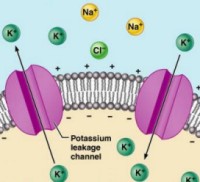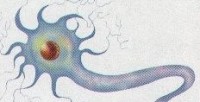Nerve Signals
Resting Potential
 The cell expends lots of energy in pumping sodium ions to the outside of the cell and pumping potassium ions to the inside of the cell. There is some diffusion of both ions across the cell membrane to the side where the concentration of each ion is less. Since the potassium ion leaks more easily, there is a slight elevation of positive charge on the outside of the cell from slightly more potassium ions in the extracellular fluid. Inside the cells are also negatively charged proteins and nucleic acid molecules that are too large to cross the cell membrane. As a result, the outside of the cell is positively charged relative to the inside of the cell. This membrane potential (called a resting potential in nerve cells) is a characteristic of cells in general and provides an electric force that affects the movement of ions across the membrane.
The cell expends lots of energy in pumping sodium ions to the outside of the cell and pumping potassium ions to the inside of the cell. There is some diffusion of both ions across the cell membrane to the side where the concentration of each ion is less. Since the potassium ion leaks more easily, there is a slight elevation of positive charge on the outside of the cell from slightly more potassium ions in the extracellular fluid. Inside the cells are also negatively charged proteins and nucleic acid molecules that are too large to cross the cell membrane. As a result, the outside of the cell is positively charged relative to the inside of the cell. This membrane potential (called a resting potential in nerve cells) is a characteristic of cells in general and provides an electric force that affects the movement of ions across the membrane.Action Potential
When the nerve cell is sufficiently stimulated, sodium channels in the cell membrane open and sodium ions flood into the cell, depolarizing the cell membrane (the charge reverses: inside becomes positive relative to the outside). After about half a millisecond, the sodium channels close again and potassium channels open, allowing positive potassium ions to move to the outside of the cell. The cell is quickly repolarized. The sodium-potassium pump works to restore the proper concentrations of the ions inside and outside the cell. It takes only a few sodium ions to enter the cell and reverse the polarity, and it does not take long to reset the system.
 |
Muscle Stimulation
When the nerve terminates at a muscle fiber, the nerve impulse causes the end of the nerve to release a chemical transmitter - acetylcholine - that travels across the very short distance of the neuromuscular junction. When acetylcholine reaches the muscle, it depolarizes the muscle cell membrane and initiates an action potential that causes the fibers to contract. After stimulating the muscle fibers to contract, acetylcholine is broken down by enzymes and the resting potential of the muscle membrane is restored.
Homeostatic Sensitivity
Although only 2% of the mass of the human body, the brain uses 20% of the body's energy. Nerve cells are among the most energetically demanding cells in the body. Since they do not have any means of energy storage, they require a constant supply of glucose and oxygen. If glucose drops too low, the person goes into a coma. Moreover, if the brain lacks oxygen for between 3-7 minutes under normal conditions, the nerve cells die never to recover.
Excerpted and adapted from: Curtis, H., and N. S. Barnes. 1989. Biology. Worth Publishers, Inc., NY., Vander, A., J. Sherman, and Dorothy Luciano. 2001. Human Physiology. The Mechanisms of Body Function. McGraw Hill. Boston., Earlier Model of Human Brain's Energy Usage Underestimated Its Efficiency